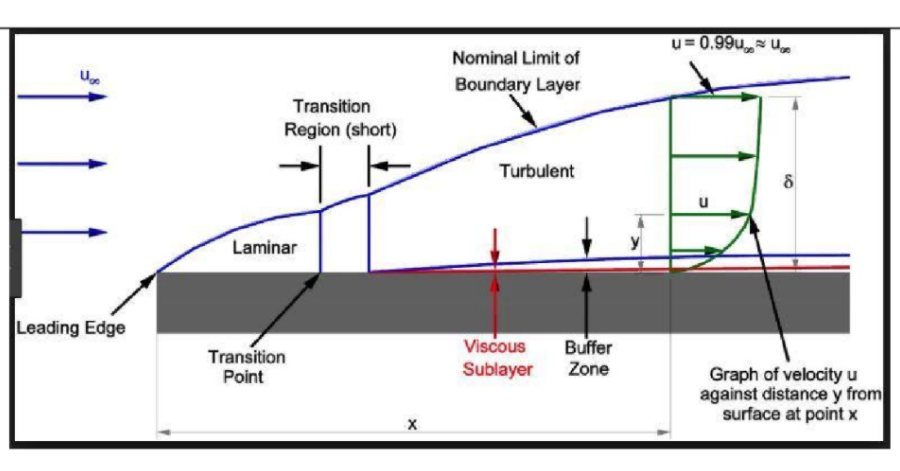

At sufficiently high shock-incidence angles, the boundary layer transitions to turbulence via breakdown of near-wall streaks shortly downstream of the shock impingement, without the need of any inflow free-stream disturbances. The interaction between an incident shock wave and a Mach-6 undisturbed hypersonic laminar boundary layer over a cold wall is addressed using direct numerical simulations (DNS) and wall-modeled large-eddy simulations (WMLES) at different angles of incidence.

Numerical experiments reveal that the new method is more accurate and more robust than existing methods, and it is applicable for flows over a wide range of Reynolds numbers. The superior performance of the new method over various existing methods is demonstrated by applying the methods to laminar and turbulent boundary layers and two flows over airfoils. The new method is parameter free, and can be deployed for both internal and external flows without resorting to an iterative procedure, numerical integration, or numerical differentiation.

The boundary-layer thickness δ99 is then defined as the location where U/UI = 0.99, which is consistent with its classical definition for the zero-pressure-gradient boundary layers (ZPGBLs). In this work, a new method is developed based on a local reconstruction of the "inviscid" velocity profile UI resulting from the Bernoulli equation.
#Boundary layer free#
The part of the atmosphere above the PBL is referred to as the Free Atmosphere.While the computation of the boundary-layer thickness is straightforward for canonical equilibrium flows, there are no established definitions for general non-equilibrium flows. The top of the boundary layer is often marked by a temperature inversion, especially at night.Ībove this planetary boundary layer, turbulence due to Earth-atmosphere interaction is less marked and, in mid latitudes, the geostrophic wind prevails following the same path as isobars. In reverse, stronger wind speeds add to the likelihood of more vigorous convection in the daytime by increasing the extent to which air is mechanically mixed. The general tendency for wind speeds to be lower at night when there is already a much reduced opportunity for convection adds to that effect. At night, thickness will usually reach its diurnal minimum because a lower air temperature means that the atmosphere is more dense and therefore relatively more stable. Variation in thickness usually occurs on both a diurnal and a seasonal basis. The thickness of the planetary boundary layer is rarely constant but does not usually exceed about 1000 metres / 3000 feet. Although the geostrophic wind theory is mainly representative of winds in mid-latitudes, friction effects on wind as described above is valid for all latitudes. However, in the PBL, due to friction with the Earth's surface, winds tend to “flow across” isobars at angles of up to 30 degrees and towards the region of lower pressure. PBL science is rather complex as a result, and comprises the study of micro-meteorology.ĭepicted on weather charts, winds tend to follow isobars, as a result of the geostrophic wind theory which balances pressure gradient force with Coriolis force. A combination of some or all variables is possible. The above-mentioned examples are but a few of the many variables which affect air in the PBL. Venturi effects due to orographic topography, for example, may speed up the wind, whereas forests may slow it down. The topography of the Earth's surface, be it hilly or flat, forested or grassy, etc, all affect the flow of air by way of direction and speed. Water, having a larger heat capacity than terrain, may heat the air with less intensity, and therefore land-sea wind flows are affected, resulting in the sea and land breezes. On hot summer days, for example, intense heating of the Earth's surface warms the air above said surface, which in turn changes the stability of the air. However, at levels near the surface of the Earth, solar heating and terrestrial cooling do affect the temperature of the air immediately above the Earth's surface. Surface friction, terrain and solar heating all influence, to varying degrees, that part of the atmosphere closest to the surface, leading to mechanical turbulence, convective activity and variation in wind direction and speed.Īir is a poor conductor of energy - which in Meteorology is basically in the form of heat. It is sometimes referred to as the Atmospheric Boundary Layer (ABL). The Planetary Boundary Layer (PBL) is the lowest part of the troposphere which is subject to direct earth-atmosphere influence because of its proximity to the surface of the earth.


 0 kommentar(er)
0 kommentar(er)
